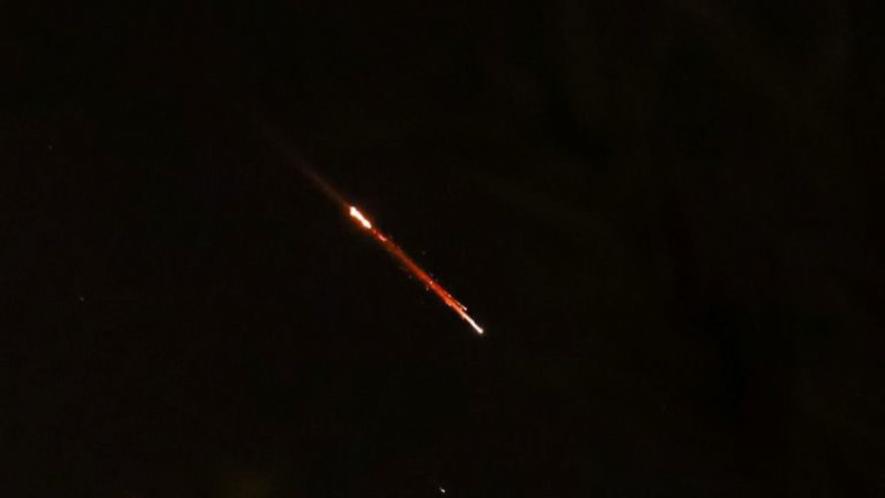US Diplomacy Gains Traction in West Asia

Objects lighting up the sky above Jerusalem after Iran launched drones and missiles towards Israel, April 13, 2024.
With the outbreak of Israel’s Gaza war six months ago, a narrative mushroomed in the morass of the low, soft marshy land of geopolitics that the United States is caught in a quagmire that would compel its retrenchment in Eurasia and severely weaken the Biden administration’s strategy in the Asia-Pacific.
To what extent Moscow and Beijing subscribed to that narrative is debatable, given their scepticism drawn from past experience with the US foreign policy strategies. Be that as it may, what emerges is that NATO’s eastward expansion, the end of Western hegemony in West Asia and the US’ containment strategy against China are inter-related. The Biden Administration’s challenge is to adapt to a new normal.
Of course, there are variables in the situation — principally, the uncertainties in the future of US engagement. Within the US, there are radically different visions of the country’s role in the world and its relationships with allies. Abroad, there are concerns about American isolationism and reliability regardless of which candidate wins the elections in November.
In the past week alone, although the tensions in West Asia were spiking dangerously, that didn’t deter US President Joe Biden from hosting a truly historic state visit by Japanese Prime Minister Fumio Kishida. The subtext, predictably, was the tensions in Taiwan Straits. The US and Japan signed over 70 defence agreements and there is much talk about the letter’s induction into AUKUS and the Five Eyes. (here and here) Biden and Kishida also took part in a first-ever Trilateral Leaders Summit with President Ferdinand Marcos Jr. of the Philippines, where the focus was on containment of China.(here and here)
Again, Washington announced sanctions against the import of Russian-origin aluminium, copper, and nickel and coordinated with the UK to crack down on the trade of these metals on global exchanges with a view “to target the revenue Russia can earn” to fund its military operation in Ukraine.
Indeed, the agenda of NATO foreign ministers meeting on the seventy-fifth anniversary of the alliance at Brussels on April 3-4 included a discussion on “how NATO could assume more responsibility for coordinating military equipment and training for Ukraine anchoring this within a robust NATO framework.” That doesn’t look like a US retrenchment from Eurasia.
In fact, NATO secretary-General Jens Stoltenberg underscored that “Ukraine will become a member of NATO. It is a question of when, not if.” He also co-related the Ukraine war with the rising tensions over Taiwan. In his words, “Russia’s friends in Asia are vital for continuing its war of aggression. China is propping up Russia’s war economy. In return, Moscow is mortgaging its future to Beijing.” Stoltenberg was articulating the US’ viewpoint.
Biden raised with Chinese President Xi Jinping during their telephone conversation on April 2 Washington’s “concerns over the PRC’s support for Russia’s defence industrial base and its impact on European and transatlantic security”!
Clearly, although the US and NATO are unprepared for waging an industrial war with Russia in Europe, it isn’t as if the US is in retreat, either. NATO’s upcoming Washington Summit in July is sure to be dominated by the Ukraine war and the dual containment of Russia and China.
According to some reports, there is already some talk among NATO countries — France, the UK and Poland — that if the Russian offensive reaches the Dnieper and Ukrainian military collapses out of exhaustion, they should intervene to hold the frontline.
Biden addressed the Congress with a communication dated April recommending the extension for one more year of the national emergency declared in Executive Order 14024 (dated April 15, 2021) “with respect to specified harmful foreign activities of the Government of the Russian Federation.” In the US’ assessment, the war in Ukraine is far from over and it will be a long haul for Russia to gain control over the whole country.
Suffice to say, the West Asian crisis is anything but a “stand alone” event. Make no mistake that the BRICS membership of four West Asian countries, who were allies of the US, marks the eclipse of petrodollar. The decision dovetails into the Russian project of “de-dollarisation” and rollback of US hegemony.
One of the four regional states joining BRICS is Iran, an ardent supporter of “de-dollarisation”, with which the Biden Administration keeps contact over the West Asian situation. The latest developments following Israel’s Damascus attack have led to an intensification of the contacts aimed at avoiding any misunderstandings.
These contacts have reached a qualitatively new level lately. Some degree of coordination is possible now, as Iran’s calibrated drone and missile strikes on Israel on Saturday night implied.
A commentary by the Iranian news agency IRNA spelt out seven “dimensions” of Iran’s retaliation. Now, the US undoubtedly has a moderating influence on Israel. According to reports from DC, Biden has drawn the red line that the US refuses to participate in any future Israeli retaliation against Iran’s unprecedented direct attack on Saturday night.
Such a dramatic turn to the power dynamic in the region was simply unthinkable up until now. IRNA noted that it indicated “an understanding of this matter by the main supporter of the Zionist regime.” The big question now is where is all this leading to.
To be sure, the US diplomacy is gaining traction and it will have a positive effect on downstream events relating to the Palestine problem. During the past six-month period, Washington’s networking with its traditional allies — Qatar, Saudi Arabia, Egypt and the Palestinian Authority, in particular — has intensified.
As it matures steadily as practical cooperation to steer Gaza out of the dark tunnel of war and bloodshed, it will add gravitas to the US’ overall standing as peacemaker and even enable it to regain the leadership role it previously enjoyed, in a new form.
The future trajectory of US-Iran contacts remains to be seen. Will the nascent stirrings die a sudden death? Or, will they generate a critical mass of mutual confidence so that the deeply troubled ties turn into a working relationship? The US-Iran mutual rhetoric has mellowed considerably in the recent period.
Credit must be given to Tehran for reading the tea leaves early enough, as incipient differences began cropping up between Washington and Tel Aviv. Tehran sensed correctly that those differences might turn into discord.
Meanwhile, the US is realistic enough to understand that the containment strategy against Iran has outlived its utility and further pursuit of it becomes meaningless when regional states are preferring reconciliation.
In effect, Iran has gained much strategic depth and strengthened its strategic autonomy — thanks to the strengthening of its ties with Russia and China and rapprochement with Saudi Arabia. The profound meaning of Iran’s direct missile strike against Israel cannot be lost on anyone.
The IRNA commentary says: “Iranian attack was the first direct confrontation between the Islamic Republic and the fake Zionist regime. This is very significant in terms of historical issues. Effective attacks deep inside the occupied territories has been an unfulfilled dream of Islamic countries since 1967, which have now come true thanks to efforts by the cradle of resistance in the region. For the first time ever, Iranian aircraft attacked enemies of Al-Aqsa Mosque in the skies over this holy site.”
The US knows Iran to be a tough negotiator who will not compromise on its interests. Washington will look for daylight in the Russian-Iranian relationship, which holds tantalising possibilities to isolate Moscow in the conditions under sanctions.
Iran makes an ideal energy partner for European economies replacing Russia. Suffice to say, the chances are that the endgames in Ukraine war and the Israel-Arab conflict, as they run on parallel tracks, may create synergy going forward.
MK Bhadrakumar is a former diplomat. He was India’s Ambassador to Uzbekistan and Turkey. The views are personal.
Courtesy: Indian Punchline
Get the latest reports & analysis with people's perspective on Protests, movements & deep analytical videos, discussions of the current affairs in your Telegram app. Subscribe to NewsClick's Telegram channel & get Real-Time updates on stories, as they get published on our website.
























